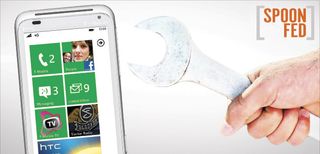6 Fixes Windows Phone 7.5 Needs Now

Judging by the 55-foot tall Windows Phone replica standing in midtown Manhattan this week, I think it's safe to say that Microsoft is pretty serious about making its platform a mainstream hit with consumers after a first-year flop. And based on our reviews of the first Windows Phone 7.5 devices, I'd say the company is off to a good start. Handsets like the $49 Samsung Focus Flash and $99 HTC Radar 4G are good enough to attract first-time smartphone owners and BlackBerry abandoners, as well as those who just find Android too geeky.
However, now that I'm spending a lot more time with Windows Phones, there are some definite drawbacks--some that could be fixed overnight and some that will take more time to address. Here's my wish list.
1. Don't Hide So Much Stuff
I understand the desire to make your interface clean and uncluttered, but sometimes Windows Phone goes too far. For example, you need to press the top of the display to see your signal strength and battery life, two pretty critical pieces of information. And why not always show the cc and bcc fields in outgoing emails? Instead, you must press three dots at the bottom of the screen and then tap "show cc & bcc." Yes, other platforms do this too but that doesn't make it right.
One more extreme example. To share a webpage via Facebook, users need to tap three dots, then tap share page, then tap social networks, and then select the service you would like to use. It's time to streamline, folks.
2. Add USB Drag and Drop
Anyone who uses a Windows Phone device for the first time will be shocked to learn that you need to download Zune desktop software to get photos and videos off their phones (although you can auto-upload pics to SkyDrive wirelessly). Syncing music also requires Zune software, as does updating your OS. With Android phones, you can just open Windows Explorer and drag and drop files to and from your phone as if it were a USB drive. Granted, not everyone is comfortable doing this, but it should at least be an option.
Stay in the know with Laptop Mag
Get our in-depth reviews, helpful tips, great deals, and the biggest news stories delivered to your inbox.
3. Give Us Real 4G, Real Fast
Microsoft is right when it says that the single-core processors inside its latest phones feel as fast as dual-core CPUs inside Android superphones. But speed is about more than just opening apps and multitasking. Windows Phones don't support 4G LTE yet, and so-called 4G handsets like the HTC Radar 4G on T-Mobile are limited to a theoretical max of 14.4 Mbps, as opposed to 42 Mbps for the Samsung Galaxy S II on the same carrier. The Radar loaded webpages fast enough, but this morning it took 24 seconds for the device to refresh the People hub after I opened it. That's too long.
4. Let Your Partners Innovate
Although HTC and Samsung can add their own hubs and apps, there's nothing that really tells you who made a given Windows Phone device other than the logo on the back. I say allow your partners to have a home screen all to themselves, say to the left of the Start screen. That way HTC can sprinkle more of its Sense experience on its devices, for example. Or maybe let your partners do stuff like what Lenovo did with Android Honeycomb, adding a little X next to apps in the multitasking menu so you can close them.
5. Offer Better Free Games
I handed my 4-year-old and 7-year-old a Windows Phone earlier this week to play Angry Birds and my daughter came back to me later and said, "we need to pay." I forgot that this title was just a free trial, offering the first stage but locking out the rest. Fruit Ninja is another game you can get for free on Android, but it's $2.99 here with a free trial. There's a decent selection of free titles on Windows Phones, but it’s clear that Microsoft is pushing the more premium Xbox Live titles.
6. Let Us Pick Up Where We Left Off
If you're going to make people pony up for games you can get for free elsewhere, you should be able to return to the action at any time. Angry Birds forced us to start over when we selected the app from the multitasking menu. Developers need to get their Mango acts in gear. Every app in the top ten of every category in the Marketplace should be optimized for Windows Phone 7.5 by now.

